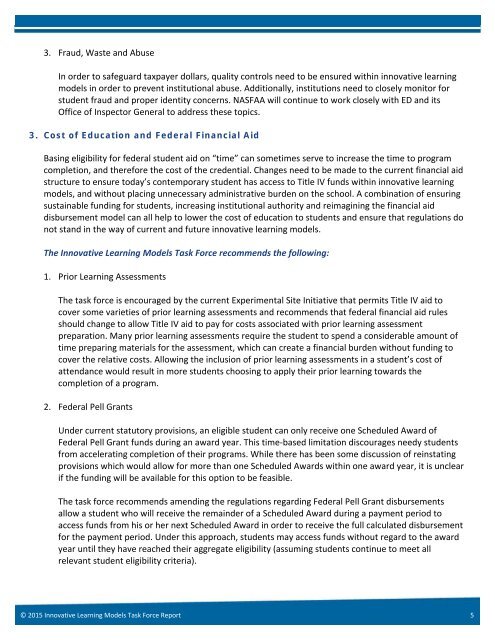INNOVATIVE LEARNING MODELS
Innovative_Learning_ModelsTFReport
Innovative_Learning_ModelsTFReport
You also want an ePaper? Increase the reach of your titles
YUMPU automatically turns print PDFs into web optimized ePapers that Google loves.
3. Fraud, Waste and AbuseIn order to safeguard taxpayer dollars, quality controls need to be ensured within innovative learningmodels in order to prevent institutional abuse. Additionally, institutions need to closely monitor forstudent fraud and proper identity concerns. NASFAA will continue to work closely with ED and itsOffice of Inspector General to address these topics.3. Cost of Education and Federal Financial AidBasing eligibility for federal student aid on “time” can sometimes serve to increase the time to programcompletion, and therefore the cost of the credential. Changes need to be made to the current financial aidstructure to ensure today’s contemporary student has access to Title IV funds within innovative learningmodels, and without placing unnecessary administrative burden on the school. A combination of ensuringsustainable funding for students, increasing institutional authority and reimagining the financial aiddisbursement model can all help to lower the cost of education to students and ensure that regulations donot stand in the way of current and future innovative learning models.The Innovative Learning Models Task Force recommends the following:1. Prior Learning AssessmentsThe task force is encouraged by the current Experimental Site Initiative that permits Title IV aid tocover some varieties of prior learning assessments and recommends that federal financial aid rulesshould change to allow Title IV aid to pay for costs associated with prior learning assessmentpreparation. Many prior learning assessments require the student to spend a considerable amount oftime preparing materials for the assessment, which can create a financial burden without funding tocover the relative costs. Allowing the inclusion of prior learning assessments in a student’s cost ofattendance would result in more students choosing to apply their prior learning towards thecompletion of a program.2. Federal Pell GrantsUnder current statutory provisions, an eligible student can only receive one Scheduled Award ofFederal Pell Grant funds during an award year. This time-based limitation discourages needy studentsfrom accelerating completion of their programs. While there has been some discussion of reinstatingprovisions which would allow for more than one Scheduled Awards within one award year, it is unclearif the funding will be available for this option to be feasible.The task force recommends amending the regulations regarding Federal Pell Grant disbursementsallow a student who will receive the remainder of a Scheduled Award during a payment period toaccess funds from his or her next Scheduled Award in order to receive the full calculated disbursementfor the payment period. Under this approach, students may access funds without regard to the awardyear until they have reached their aggregate eligibility (assuming students continue to meet allrelevant student eligibility criteria).© 2015 Innovative Learning Models Task Force Report 5



